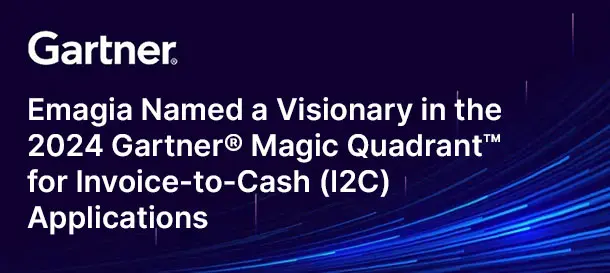Order-to-Cash automation with AI brings data-driven intelligence to finance—speeding credit decisions, streamlining invoicing, automating collections, reducing disputes and increasing match accuracy to improve working capital and customer experience.
Understanding the Order-to-Cash Cycle and the Role of AI
What is the Order-to-Cash (O2C) cycle?
The Order-to-Cash process describes the end-to-end financial workflow that begins when a customer order is captured and ends when the payment is applied and revenue is recognized. It includes order entry, credit assessment, billing and invoicing, receivables monitoring, collections, deductions & disputes, cash application and reporting.
Why the O2C cycle matters for working capital, cash flow and customer satisfaction
An efficient O2C cycle directly impacts a company’s liquidity and profitability. Metrics like Days Sales Outstanding (DSO) reflect how long cash remains tied up in receivables. Delays in billing or collections reduce the speed of cash conversion. On the customer side, invoice errors, long disputes or unresponsive collections harm satisfaction and retention. Improving each stage strengthens both financial performance and customer relationships.
What is Order-to-Cash automation with AI?
Order-to-Cash automation with AI integrates machine learning, natural language processing, predictive analytics and robotic process automation into the O2C workflow. AI does more than automate — it predicts late payments, routes exceptions, detects anomalies before they escalate, and enables teams to act proactively.
The evolution of O2C: manual to automation to AI-driven
Finance functions have progressed from paper and spreadsheets to rule-based automation and now to AI-driven systems that learn from data. This maturity journey changes the role of finance from transaction processing to strategic decision-making.
Core benefits
- Faster cash conversion and reduced DSO
- Improved invoice accuracy and fewer disputes
- Higher straight-through processing (STP) rates in cash application
- Real-time analytics and forecasting for finance leaders
Main challenges
- Data quality and fragmented systems
- Legacy ERP integration complexity
- Change management and adoption by finance teams
- Model transparency, auditability and regulatory compliance
See also: What is Autonomous Finance?
The AI-Powered Foundations of the Order-to-Cash Cycle
AI now sits at the core of modern O2C, enabling continuous learning and end-to-end orchestration: from intelligent credit management to predictive collections and automated cash application. Below are the stages where AI delivers the most value.
1. Intelligent Credit Management
AI ingests customer behavior, transaction history and external market signals to produce dynamic credit scores and real-time risk profiles. This enables faster onboarding, smarter credit limits and reduced bad-debt exposure.
- Predictive risk scoring
- Automated limit adjustments
- Integration with external data feeds
2. Automated Order Processing
Document recognition and AI-driven workflows automate order capture and verification. Exceptions are routed to humans only when necessary, eliminating many manual delays.
3. Smart Invoicing and Billing Automation
AI validates invoices against POs, delivery records and contracts, catching anomalies before they reach the customer. Generative techniques can also personalize communications to improve clarity and reduce disputes.
4. Predictive Receivables and Collections
Predictive models classify accounts by payment likelihood and recommend the best outreach cadence and channel. This proactive engagement shortens DSO and improves collection efficiency.
5. Intelligent Deductions and Dispute Resolution
NLP and ML categorize deduction types, match supporting evidence and route cases for fast resolution. Over time, the system learns root causes and prevents recurring problems.
6. Cash Application Reinvented
Machine learning matches payments to invoices even with incomplete remittance data, reducing unapplied cash and improving liquidity visibility.
7. Data-Driven Insights and Continuous Optimization
Consolidated data feeds into dashboards and allows finance leaders to run scenario analysis, compare regions and model ‘what-if’ forecasts for smarter decision-making.
Broader Business Impact
- Faster quote-to-cash velocity for sales
- Operational visibility for operations teams
- Executive dashboards linking finance efficiency to strategic outcomes
Analyst insight: Deloitte and McKinsey note that advanced AI O2C implementations can deliver material reductions in invoice-to-cash time and manual processing costs.
Real-World Use Cases and Industry Applications
AI is already delivering measurable benefits across industries. Below are practical use cases that illustrate impact and adoption.
AI-Driven Credit Risk Prediction in Manufacturing
Manufacturers use AI to analyze distributor behavior, payment patterns and macro signals. This early detection reduces bad debt and allows proactive credit rebalancing.
Retail and Consumer Goods: Automated Collections Strategy
Retailers segment customers using ML, personalize reminders, and automate follow-ups—improving recovery while protecting customer relationships.
Technology: AI-Augmented Cash Application
Software firms use ML to reconcile electronic payments to subscription invoices with high STP rates, improving real-time reporting for treasury teams.
Logistics: Predictive Deductions Management
Logistics firms analyze claims to detect root causes and reduce recurring disputes—accelerating resolution and reducing operational friction.
Healthcare: Compliance-Driven Invoice Validation
Hospitals and clinics use AI to match claims to complex regulatory rules and payer contracts, reducing rejections and manual follow-up.
Banking: Intelligent Receivables Forecasting
Treasury teams leverage AI forecasts to optimize liquidity, model scenarios and manage daily cash operations with high precision.
Generative AI in Communications
Generative models help draft empathetic, brand-aligned communications for reminders and dispute resolution across languages and regions.
Cross-Industry Benchmarks
- Up to 50% faster dispute resolution
- 20–35% improvement in cash flow visibility
- 30% increase in on-time collections via predictive prioritization
Selected Case Studies
Electronics Distributor: Reduced DSO by 18 days using predictive collections.
Professional Services: Achieved 97% reconciliation accuracy with ML matching.
FMCG: Cut dispute cycle time from 14 days to 3 using automated deduction triage.
See also: How AI in Order-to-Cash Enhances Finance
Building an AI-Driven Order-to-Cash Strategy
Successful AI adoption in O2C is strategic: define objectives, build data foundations, pilot, and scale with governance and change management.
1. Define Vision and Objectives
- Set SMART targets like DSO reduction and STP rates.
- Secure executive sponsorship for cross-functional alignment.
2. Assess O2C Maturity
Map current processes and benchmark them; determine where AI yields fastest ROI.
3. Establish Data Governance
Unified data models, master data management and privacy controls support reliable AI outcomes.
4. Select Technology Stack
- AI/ML engines for prediction
- OCR and NLP for document intelligence
- RPA for rule-based tasks
- Real-time analytics and dashboards
5. Pilot, Learn, and Scale
Start with focused pilots (e.g., collections), capture results, then expand.
6. Governance and Ethics
Establish explainability, audit trails and bias monitoring for all models used in finance decisioning.
7. Measure ROI
Track DSO, auto-match rates, dispute resolution time and collections cost per invoice to evaluate impact.
8. Change Management
Upskill teams, create AI champions and set up a Center of Excellence to drive adoption.
Strategic Roadmap
- Map processes and identify friction points
- Run pilots and validate ROI
- Integrate feedback and scale
- Govern, measure and optimize continuously
How AI Transforms Deductions and Cash Application
Understanding Deductions
Deductions appear when customers short-pay due to disputes, promotions or shipment issues. AI classifies deductions, validates claims and automates remediation.
AI-Powered Deductions Classification
ML categorizes claims and surfaces high-impact items for prioritization, reducing revenue leakage.
Automatic Matching and Validation
AI matches claims to contracts, shipment records and promotions—valid claims are processed automatically; invalid ones are routed for review.
Cash Application Reimagined
OCR and probabilistic matching reconcile payments to invoices even without clear remittance information, learning from human corrections to improve over time.
End-to-End Visibility
Dashboards show unapplied cash, predicted inflows, and pending deductions for operational clarity and treasury planning.
Business Benefits
- Faster posting and lower unapplied cash
- Reduced DSO and improved forecasting
- Smarter deduction prevention and resolution
How Emagia Helps Enterprises Achieve Autonomous Order-to-Cash Transformation
Emagia provides an AI-native O2C platform that unifies credit, billing, collections, deductions and cash application. Its models and digital assistant (Gia) continuously learn and improve, delivering autonomous and predictive finance operations.
Unified Platform
End-to-end coverage eliminates silos and ensures consistent data flow for superior decisioning.
Predictive Analytics
Forecast payment behavior, spot risk and prioritize collections with data-driven confidence.
Cognitive Automation
Automate document processing, remittance extraction and matching at scale.
Digital Assistant: Gia
Gia helps collectors and finance teams with conversational insights, task automation and recommended actions.
Outcomes Delivered
- Up to 90% automation in cash application
- Significant DSO reduction
- Faster dispute resolution and improved cash predictability
Emagia integrates with ERP systems and scales across global operations, helping enterprises move from automation to autonomous finance.
Frequently Asked Questions About AI in the Order-to-Cash Cycle
What is the Order-to-Cash (O2C) cycle in finance?
The O2C cycle starts when a customer places an order and ends when the company receives payment. It covers order management, credit approval, invoicing, collections, dispute handling and cash application.
How does AI improve the Order-to-Cash process?
AI automates repetitive tasks, predicts payment delays, analyses behavior, and recommends actions—enabling proactive collections, faster cash application and fewer disputes.
What are the main benefits of Order-to-Cash automation with AI?
Faster cash conversion, lower DSO, improved match accuracy, reduced manual effort and better forecasting are core benefits.
Which parts of O2C can be automated with AI?
Credit scoring, invoicing, payment matching, collections prioritization, dispute classification, and cash forecasting are all strong AI candidates.
Can AI prevent deductions and disputes?
Yes. AI detects recurring causes and flags anomalies before invoices are sent, reducing the incidence of deductions and disputes.
Is AI suitable for all industries?
Industries with high transaction volumes—manufacturing, retail, healthcare, tech and finance—benefit most, though any business with receivables can gain value.
What is the future of AI in O2C?
The future is autonomous finance: systems that predict, recommend and in many cases execute actions to optimize working capital with minimal human intervention.




